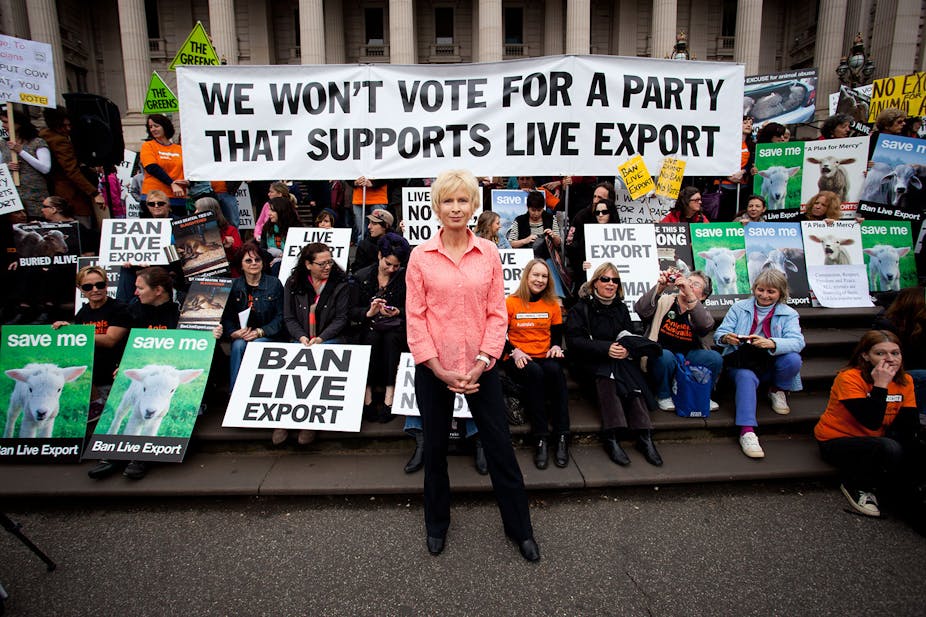Although many Australians may feel like they heard the expression “live export” or “live animal exports” for the first time recently, the selling of sheep and cows to be slaughtered overseas has a long history in this country.
Christine Townend, who founded Animal Liberation NSW, and Patty Mark who founded Animal Liberation Victoria (ALV) both tell stories of anti-live export protests dating back 30 years.
In 1985, an Australian Senate Select Committee on Animal Welfare conducted an inquiry into the live animal export industry. Its report was not complimentary. It included the observation that “if a decision were to be made on the future of the trade purely on animal welfare grounds, there is enough evidence to stop the trade.”
A ban is a real possibility. New Zealand took the step in 2007, and the live cattle trade with Indonesia was temporarily suspended following the first Four Corners expose in 2011.
Sarah Ferguson’s original report, A Bloody Business, was something of a journalistic triumph. It won her a Logie and a Gold Walkley. The story, aided by the popularity of Lyn White and the pulling power of Animals Australia, resulted in rallies around the country; the signing of petitions; letters to MPs; the temporary suspension of trade, followed by the lifting of the ban.
My institution asked me to address concerned staff and students and for the first time the Quarterly Essay considered animals via Anna Krien’s Us & Them: On the Importance of Animals.
Much of the controversy generated by A Bloody Business seemed to relate to the Indonesians’ use of traditional rope slaughter; apparently a terrible way to kill large, flighty Australian cattle; and Meat & Livestock Australia’s attempts to aid that slaughter with the installation of specially designed restraint boxes. While the boxes may have made the Indonesian slaughters’ job safer it seemed to make the dying minutes much worse for Australian cattle.
Of those who were able to watch the broadcast, shock seemed to be the common response. Apparently when Australians saw Australian animals being slaughtered without pre-stunning they saw something very different to what Meat & Livestock Australia and LiveCorp had seen while they self-regulated the process in the preceding years.
So with the broadcast of a second Four Corners expose of Australian live exports last night, the question is: have Australian exporters learnt to see the world more like the rest of us? And, can they convince us that what appears to be mass cruelty is actually little more than a glitch in an otherwise good system?
I watched A Bloody Business and Another Bloody Business back to back. The most obvious difference I detected between May 2011 and November 2012 was that Minister Joe Ludwig would not face the cameras in 2011, but was prepared to do so a year later. He had answers ready to go, as did industry. Indeed, in the lead up to the ABC’s broadcast a coalition of live exporters wrote to every member of Parliament assuring them of the outstanding quality of Australia’s live animal export industry.
So what are the industry’s key defences? As far as I can tell there are two: live exports generate wealth and Australia’s involvement is improving animal welfare standards in receiving countries.
The money defence appears to have largely fallen into disuse. It would seem that Australia’s level of disgust at the brutal treatment of Australian animals overseas is such that the promise of wealth for some is an inadequate justification.
That leaves us with the claim that Australia’s involvement in live animal exports is improving animal welfare around the world. While it might be true that as a result of the latest Four Corners program Australia will play a role in teaching Pakistani workers how to carry out large-scale animal slaughter more humanely (although no such agreement has been reached); and while it may also be true that as a result of Australian live exports to Indonesia Australia has been able to improve slaughter methods for Australian cattle in that country, isn’t it also true that at best the only thing Australian exporters are doing is attempting to resolve problems that they generate in the first place?
Aren’t all these welfare problems a result of the very fact that Australian animals are being exported live, half way around the world? If that observation is correct then the “improving welfare in receiving countries” defence is a Catch 22. Live exports generate the welfare problems that exporters are solving via the live export trade.
It is a bloody business and I can’t see it becoming less bloody any time soon.

